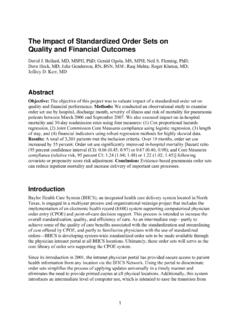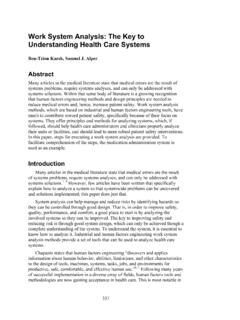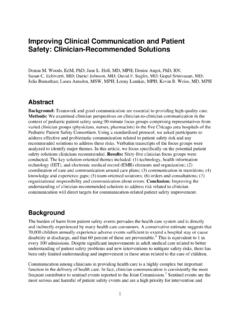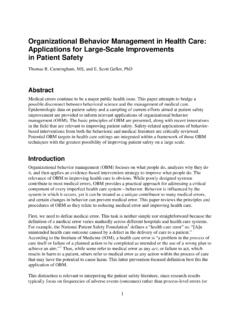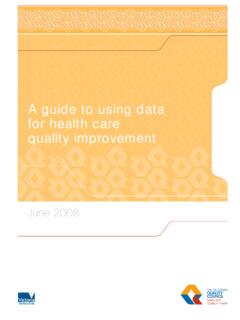Transcription of The CAHPS Ambulatory Care Improvement Guide
1 The CAHPS Ambulatory Care Improvement Guide Practical Strategies for Improving Patient Experience Section 4: Ways to Approach the quality Improvement Process Visit the AHRQ Website for the full Guide . May 2017 (updated). Table of Contents 4. WAYS TO APPROACH THE quality Improvement PROCESS 4-1. Focusing on 4-1. Understanding and Implementing the Improvement Cycle .. 4-3. An Overview of Improvement Models .. 4-14. Tools to Enhance quality Improvement Initiatives .. 4-19. Overview of the CAHPS Ambulatory Care Improvement Guide The CAHPS Ambulatory Care Improvement Guide is a comprehensive resource for health plans, medical groups, and other providers seeking to improve their performance in the domains of quality measured by CAHPS surveys. Use this Guide to help your organization: Cultivate an environment that encourages and sustains quality Improvement .
2 Analyze the results of CAHPS surveys to identify strengths and weaknesses; and Develop strategies for improving performance. The Guide includes the following sections: 1. About the CAHPS Ambulatory Care Improvement Guide 2. Why Improve Patient Experience? 3. Are You Ready to Improve? 4. Ways to Approach the quality Improvement Process 5. Determining Where to Focus Efforts to Improve Patient Experience 6. Strategies for Improving Patient Experience with Ambulatory Care The CAHPS Ambulatory Care Improvement Guide 4. Ways to Approach the quality Improvement Process 4. WAYS TO APPROACH THE quality Improvement PROCESS. Health care delivery systems that are working to improve patient experience can face daunting challenges, reflecting the need to align changes in behavior and practices across multiple levels and areas of the organization.
3 But the process of planning, testing, and eventually spreading those changes does not have to be overwhelming. Health care organizations can take advantage of established principles and approaches to quality Improvement , which are already familiar to the many providers involved in clinical quality Improvement (QI). This section of the Guide suggests a way to use the concept of microsystems to focus Three Tips for Facilitating the quality the QI process on the locus of Improvement Process responsibility for patient experience, Place a priority on encouraging provides an overview of the process of communication, engagement, and quality Improvement , discusses a few well- participation for all of the known models of quality Improvement , stakeholders affected by the QI. and presents a few tools and techniques process.
4 Learn what is most that organizations can use to address important to the people who make up various aspects of patient experience. the microsystem and look for ways to help them embrace the changes and Focusing on Microsystems begin to take ownership of them. One useful way for health plans and medical groups to approach the process of Start your implementation of Improvement is to think of the organization improvements with small-scale as a system, or more specifically, as a demonstrations, which are easier to collection of interrelated microsystems. manage than large-scale changes. The term microsystems refers to the Small-scale demonstrations or small multiple small units of caregivers, tests of change also allow you to refine administrators, and other staff who the new processes, demonstrate their produce the products of health care , impact on practices and outcomes, and who deliver care and services on a daily build increased support by basis.
5 Stakeholders. Keep in mind and remind others The concept of microsystems in health care that QI is an iterative process. You organizations stems from research findings will be making frequent corrections indicating that the most successful of the along the way as you learn from large service corporations maintain a experience with each step and identify strong focus on the small, functional units other actions to add to your strategy. who carry out the core activities that May 2017 4-1. The CAHPS Ambulatory Care Improvement Guide 4. Ways to Approach the quality Improvement Process involve interaction with customers. 1 In the context of health care, a microsystem could be: 2. A core team of health professionals. Staff who work together on a regular basis to provide care to discrete subpopulations of patients.
6 A work area or department with the same clinical and business aims, linked processes, shared information environment and shared performance outcomes. Examples of microsystems include a team of primary care providers, a group of lab technicians, or the staff of a call center. In the patient-centered medical home model, a microsystem could be the patient's care team accountable for coordination of the patient's services that address prevention, acute care, and chronic care. 3. The goal of the microsystem approach is to foster an emphasis on small, replicable, functional service systems that enable staff to provide efficient, excellent clinical and patient-centered care to patients. 4 To develop and refine such systems, health care organizations start by defining the smallest measurable cluster of activities.
7 Once the microsystems have been identified, a practice or plan can select the best teams and/or microsystem sites to test and implement new ideas for improving work processes and evaluating Improvement . 5 To provide high- quality care, the microsystem's services need to be effective, timely, and efficient for all patients,4 and preferably designed in partnership with patients and their families. Measurement and performance feedback must be part of the microsystem's principles to learn and improve. 6. If a quality Improvement intervention is successful for a microsystem, it can then be scaled to other microsystems or the broader organization. However, for successful scalability, organizations should adopt a framework for spread that will work within their structure and culture. _____. 1 Quinn J, Baruch J, Zien K.
8 Innovative Explosion: Using Intellect and Software to Revolutionize Growth Strategies. New York: Free Press; 1997. 2 Berwick DM. A user's manual for the IOM's quality Chasm' report. Health Aff (Millwood) 2002;21(3): 80-90. 3 AHRQ Patient Centered Medical Home Research Center. 4 Wasson J, Godfrey M, Nelson E, et al. Microsystems in health care: Part 4. Planning patient-centered care. Jt Comm J. Qual Patient 2003 May; 29(5):227-37(11). 5 Pronovost P, Weast B. Implementing and validating a comprehensive unit-based safety program. J Patient Saf 2005. Mar;1(1):33-40. 6 Batalden PB, Nelson EC, Edwards WH, et al. Microsystems in health care: Part 9. Developing small clinical units to attain peak performance. Jt Comm J Qual Saf 2003 Nov;29(11):575-85. May 2017 4-2. The CAHPS Ambulatory Care Improvement Guide 4.
9 Ways to Approach the quality Improvement Process Understanding and Implementing the Improvement Cycle Although QI models vary in approach and methods, a basic underlying principle is that QI is a continuous activity, not a one-time thing. As you implement changes, there will always be issues to address and challenges to manage; things are never perfect. You can learn from your experiences and then use those lessons to shift strategy and try new interventions, as needed, so you continually move incrementally toward your Improvement goals. The fundamental approach that serves as the basis for most process Improvement models is known as the PDSA cycle, which stands for Plan, Do, Study, Act. As illustrated in Figure 4-1, this cycle is a systematic series of steps for gaining valuable learning and knowledge for the continual Improvement of a product or process.
10 Underlying the concept of PDSA is the idea that microsystems and systems are made up of interdependent, interacting elements that are unpredictable and nonlinear in operation. Therefore, small changes can have large effects on the system. Figure 4-1. Plan-Do-Study-Act Cycle May 2017 4-3. The CAHPS Ambulatory Care Improvement Guide 4. Ways to Approach the quality Improvement Process The cycle has four parts: Plan. This step involves identifying a goal or purpose, formulating an intervention or theory for change, defining success metrics and putting a plan into action. Do. This is the step in which the components of the plan are implemented. Study. This step involves monitoring outcomes to test the validity of the plan for signs of progress and success, or problems and areas for Improvement . Short- cycle, small-scale tests, coupled with analysis of test results, are helpful because microsystems or teams can learn from these tests before they implement actions more broadly.


